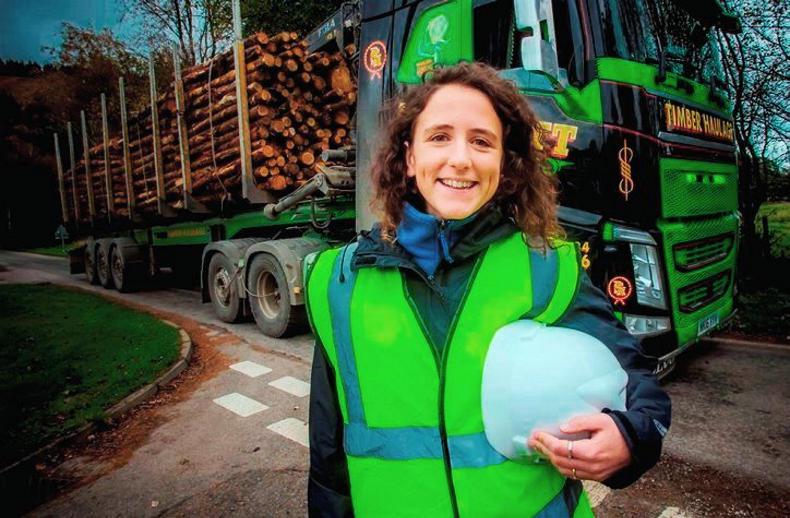Politicians and climate change commentators throughout Europe, especially Finland, Denmark, Austria, Latvia and Sweden, could be permitted wry smiles last week, when Ireland became only the second country in the world to declare a climate and biodiversity emergency. These countries are on course to achieve or surpass EU renewable energy targets of 30-50% by 2020.
This is in contrast with Ireland, which has a target to generate a modest 16% of its energy requirements from renewables by next year – which we will fail to achieve.
All the countries mentioned rely heavily on wood biomass to generate renewable energy, even Austria, which also has the added green energy advantage of hydropower. Despite this, Austria’s Bioenergy Policies and Status of Implementation” states: “The largest potential [in renewable energy] is seen as wood.”
This report identifies the important role of forestry in climate change mitigation
The role of the forest in carbon sequestration alongside carbon storage in sustainable building and carbon neutral renewable energy, are the triple benefits of a sustainable forestry programme. Countries in Europe have sufficient forests to ensure a sustainable forestry programme except Ireland, which has an overall target to expand the “forest estate from 11% to 18% by mid-century,” according to the Annual Transition Statement issued by the Department of Communications, Climate Action and Environment (DCCAE). This report identifies the important role of forestry in climate change mitigation. However, the target set by the DCCAE is about as meaningless as Ireland’s declaration of a climate emergency, as it would require an annual afforestation programme of 16,000ha. Last year, the afforestation programme reached 4,025ha – the worst performance in almost 70 years.
The target for this year, as outlined in the Department of Agriculture, Food and the Marine (DAFM) Forestry Programme 2014-2020, is 8,115ha. This will require a doubling of last year’s planting, but so far Forestry Division data and information on planting and nursery production would indicate that the sector may not even achieve last year’s dismal performance unless there is a dramatic upturn in autumn planting.
For example, afforestation financial approvals up until March amounted to 1,187ha compared with 1,887ha in 2018, according to the most recent Forestry Division monthly report.
This level of performance represents a downward trend since the infamous 20% rule, was introduced in 2010. The IFA has consistently called for a reversal of the decision that limits afforestation of unenclosed land to 20% of the total area planted in any one application.
The afforestation programme needs to be protected as it is close to collapse, especially in most Munster counties
The 20% rule, along with the cutting of grants and premiums by 30% for plantations on unenclosed land, makes the operation uneconomic even if approval is granted. While grant schemes, especially for native woodlands on some of these sites, have been introduced, the downward slide in afforestation has not been addressed. The afforestation programme needs to be protected as it is close to collapse, especially in most Munster counties. The trebling of timber production since 1988 is due mainly from timber harvesting on forests established on unenclosed land.
Reports on the importance of forestry in decarbonising our energy programme, as outlined by the DAFM (Food Wise 2025), Teagasc (An Analysis of Abatement Potential of Greenhouse Gas Emissions in Irish Agriculture 2021-2030) and the DCCAE (Annual Transition Statement) call for ambitious forestry programmes needed to mitigate climate change and achieve renewable targets.
The DCCAE maintains that 2.2Mt of CO2 per annum is forecast to be accountable against Ireland’s Effort Sharing Regulation. It targets afforested land to “ensure this figure is attained”.
It calls for a 15,000ha planting programme from 2020 and the current modest annual DAFM afforestation programme of 8,000ha from 2018-2020, which is double current average planting. With no realistic strategic plan in place to address this shortfall, it is time to declare a forestry emergency.
Forestry conference on climate change
This year’s annual forestry conference focuses on forestry and climate change, including reducing greenhouse gas emissions and the role forestry can play alongside agriculture in climate change mitigation. Entitled Forestry as a Climate Change Solution, it will also look at the role of forestry in sustainable construction and energy generation.
Interesting comparisons will be drawn with the performance of forestry in Scotland, which now has a vibrant forest industry. In this regard, Mairi Gougeon, Scotland’s Minister for Rural Affairs and Natural Environment, will discuss the performance of the sector in Scotland; while Stuart Goodall will speak on production forestry and climate change – the Scottish approach. The chief executive of the UK Confederation of Forest Industries (Confor) will address issues such as forestry and carbon sequestration, flood damage and wood energy.
The conference takes place on 30 May 2019 at the Johnstown House Hotel in Enfield, Co Meath. Registration fee is €100. For further information, contact Pat O’Sullivan, Society of Irish Foresters (info@soif.ie) or call 086-2582240.






 This is a subscriber-only article
This is a subscriber-only article










SHARING OPTIONS: